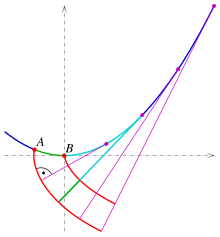
Back ناشر (منحنى) Arabic Evolventa BS Involuta Catalan Evolventa Czech Evolvente German Evolvente Spanish Evolvent Estonian Bilkari (geometria) Basque اینولوت Persian Evolventti Finnish

In mathematics, an involute (also known as an evolvent) is a particular type of curve that is dependent on another shape or curve. An involute of a curve is the locus of a point on a piece of taut string as the string is either unwrapped from or wrapped around the curve.[1]
The evolute of an involute is the original curve.
It is generalized by the roulette family of curves. That is, the involutes of a curve are the roulettes of the curve generated by a straight line.
The notions of the involute and evolute of a curve were introduced by Christiaan Huygens in his work titled Horologium oscillatorium sive de motu pendulorum ad horologia aptato demonstrationes geometricae (1673), where he showed that the involute of a cycloid is still a cycloid, thus providing a method for constructing the cycloidal pendulum, which has the useful property that its period is independent of the amplitude of oscillation.[2]
- ^ Rutter, J.W. (2000). Geometry of Curves. CRC Press. pp. 204. ISBN 9781584881667.
- ^ McCleary, John (2013). Geometry from a Differentiable Viewpoint. Cambridge University Press. pp. 89. ISBN 9780521116077.
© MMXXIII Rich X Search. We shall prevail. All rights reserved. Rich X Search